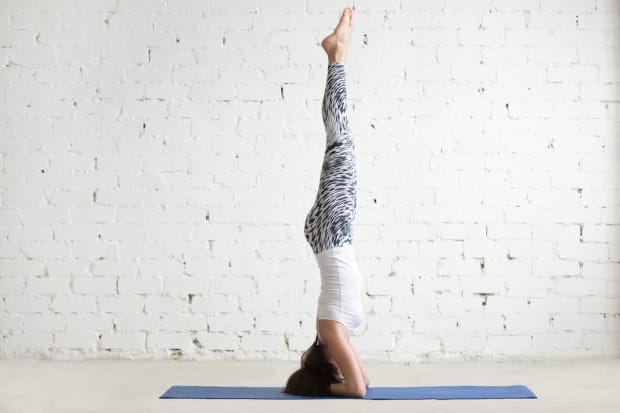The Dangers of Headstand and How to Avoid Injury
While headstand is a beneficial posture in yoga, it can be harmful if you’re not careful. These alignment tips will help you avoid the dangers of headstand.

Headstand (Sirsasana) has been called the “king of all yoga poses” because it’s so beneficial to those who practice it daily. But for yogis that do it incorrectly, it can cause immediate or gradual damage to the neck and spine. Learn to correct your alignment mistakes and prevent injury when you turn upside down.
The Benefits of Headstand
The main reason why headstand is such a popular pose that’s often an essential component of a yoga practice is because it has so many benefits when done correctly. According to Juliana Spicoluk, a yoga instructor and owner of the yoga lifestyle company Boho Beautiful, it does the following:
- Supplies fresh nutrients to the face giving you that glowing look.
- It improves circulation and gives the heart a break from having to pump blood from the feet back up to the heart.
- Lifts your mood by flushing the adrenals.
- Boosts your confidence because it’s a difficult pose to master and once you do, you feel pretty good about yourself.
The Dangers of Headstand
Though it’s undoubtedly beneficial, says Spicoluk, it can also be harmful if done incorrectly.
“The seventh vertebrae (in the neck) is the smallest in the body and it’s only meant to hold the weight of the head, not the entire body,” says Spicoluk. “You have to be really careful with the way you distribute weight in the body.”
If you do headstand incorrectly it can cause disc herniation in the neck. This occurs when the softer jelly encased in the spinal column pushes out through a crack in the tough exterior causing pain, numbness, or tingling in the neck and arms. If you have high blood pressure, says Spicoluk, you should also avoid doing headstand.
Simple Tips for Avoiding Injury in Headstand
When it comes to preventing injury, it’s all about alignment. Make sure you’re following these alignment cues, says Spicoluk (pictured in the video above).
- Start with your forearms on the ground. Try and put all (or the majority of your body weight) in your forearms rather than the crown of the head.
- If you’re working on tripod headstand, make sure that the weight of your body is in your hands, not the crown of your head.
- It’s all about core strength. In addition to the strength of your arms, much of the reason you’re able to hold yourself in place is through the strength of your core. Work on your core strength before attempting to hold headstand.
- Start small, never kick up into headstand. Lift one leg at a time. You can also start by doing headstand against the wall if you’re afraid of getting injured falling over.
- You should almost be able to lift your head. There should be so little weight on the crown of your head that you can, or almost can, lift your head off the ground.
- Try and elongate the neck and push the shoulders away from the ears. Imagine yourself creating length in the back of the neck rather than compressing the spinal column.
- Hold the posture for only as long as you can maintain the correct alignment. Many of us start off with the weight correctly distributed into the forearms or hands, but as we tire in the arms, we begin to drop weight into the head. It’s always better to come out of the pose than to lose sight of your weight distribution. As you get stronger, you’ll be able to hold the pose for a longer period of time.
- If it doesn’t feel good, listen to your body. Sometimes it’s as easy as dropping out of a pose when it hurts.
What To Do Instead of Headstand
While headstand is a beautiful posture, it’s far from the only pose with similar benefits. If it’s not working for you or you already have a neck injury that precludes you for being able to do the pose, try any number of other postures listed below:
- Wide-legged forward fold. You can get many of the benefits of an inversion just by stepping the legs wide apart and folding forward. Allow the head and neck to dangle.
- Handstand. It’s a difficult pose but it can be really fun to experiment with, here’s a guide to mastering it.
- Inversion chairs. You can also purchase inversion chairs that allow you to turn upside down without any of the risk of injury.
Related on Organic Authority
How To Choose the Best Wellness Treatments For Your Ayurvedic Dosha
Here’s How to Find the Right Meditation Class For Your Personality Type
Clearing Up These 7 Yoga Misconceptions Will Make You Want to Get Your Om On
[page_popup id=”1″]



